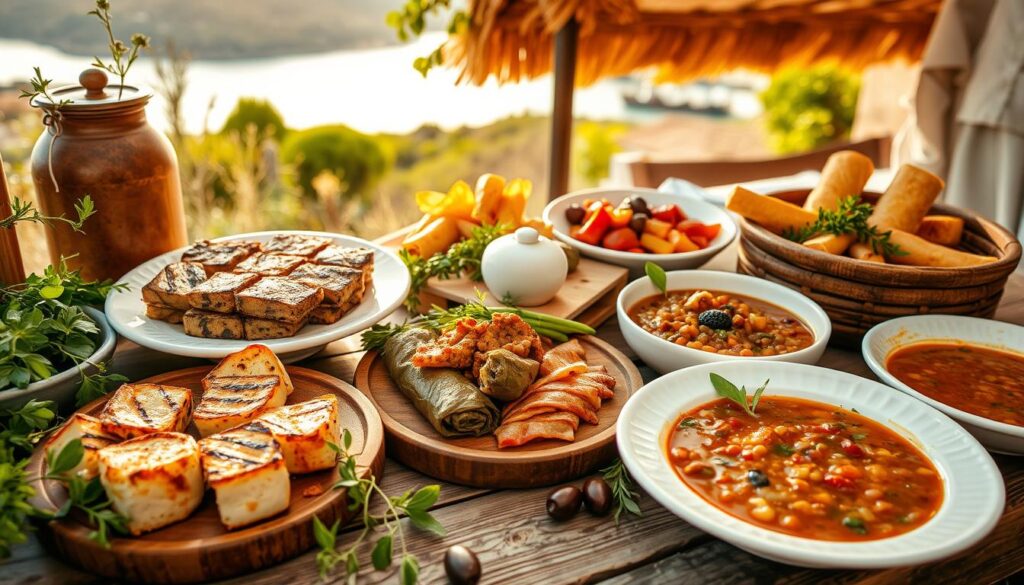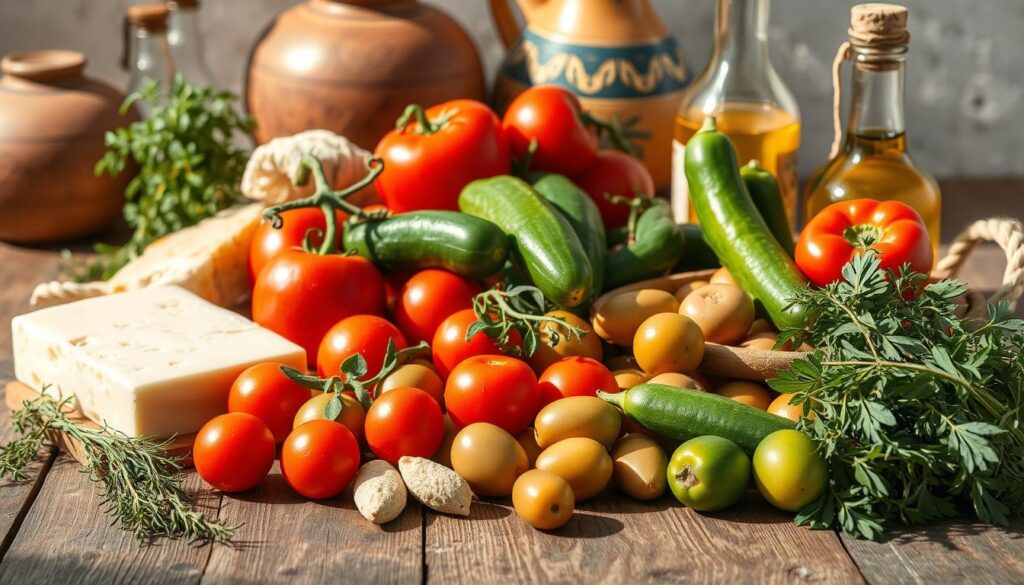Welcome to a culinary adventure that introduces you to the vibrant landscape of food in Cyprus. With its rich cultural heritage, Cypriot cuisine is a delightful amalgamation of flavors and traditions woven together through generations. Here, food is not just sustenance; it is a way of life, a shared heritage that reflects the island’s storied past and diverse influences. From classic dishes to vibrant local ingredients, join us as we explore what makes this Mediterranean paradise a haven for food lovers.
For those intrigued by culinary traditions and travel, the book Cyprus: A Culinary Journey edited by Marianne Salentin-Trager offers an insightful peek into what Cypriots cherish in their cuisine while highlighting the rich flavors that define the Mediterranean diet. Prepare to savor iconic dishes and discover local ingredients that play a crucial role in crafting delectable meals, showcasing the enduring spirit of Cyprus‘ culinary culture.
Key Takeaways
- Cypriot cuisine reflects a blend of historical influences and modern interpretations.
- Key ingredients such as fresh vegetables, seafood, and local cheeses are vital to the Mediterranean diet.
- Meze, a traditional Cypriot dining experience, features 20+ plates designed for sharing, showcasing a variety of flavors.
- Halloumi cheese, a beloved staple, can only be produced in Cyprus, ensuring its unique quality and taste.
- Understanding the flavors of Cyprus means celebrating its rich food culture that has evolved through centuries.
Exploring Cypriot Cuisine
Cypriot cuisine offers a tantalizing journey into the island’s rich heritage, influenced by various cultures throughout history. The remarkable historical influences from the Romans, Venetians, Greeks, and Turks have significantly shaped what we recognize as traditional Cypriot dishes today. Rustic cooking practices embody the essence of local traditions, enhancing the flavors that make this cuisine so unique. Ingredients such as olive oil are foundational in many recipes due to its abundance on the island, while fresh vegetables and seasonal produce ensure meals are both delicious and nutritious1.
Historical Influences on Food in Cyprus
The history of Cyprus is reflected in its diverse array of culinary offerings. Dishes like Kleftiko—slow-cooked lamb—exhibit an intertwining of local traditions and foreign influences, while the inclusion of items like Halloumi cheese signifies a proud local specialty known worldwide1. Street food has become vital to Cypriot culture, being readily available year-round, thanks to the favorable Mediterranean climate2. Furthermore, vibrant food festivals attract not only locals but visitors eager for a slice of authentic Cypriot culinary artistry, emphasizing the island’s celebratory approach to food2.
Key Ingredients in Cypriot Dishes
Central to the flavor profile of Cypriot cuisine are its key ingredients. Olive oil serves as a significant feature, while dishes often showcase seasonal produce, enhancing their freshness. Vegetarians and vegans now find a plethora of options as plant-based fare rises in popularity among both locals and travelers2. Dining experiences often revolve around communal styles like meze, where diners can sample numerous small plates—sometimes as many as thirty-five varieties—creating a festive atmosphere1.

Traditional Dishes You Must Try
Cypriot cuisine is a delightful exploration of flavors, where traditional dishes take center stage. One cannot visit Cyprus without indulging in the exquisite experience of Classic Cypriot Meze. This communal dining approach features an assortment of over 20 small dishes, allowing diners to taste a variety of local specialties. Among the stars of a Cypriot Meze are halloumi cheese, which has gained international fame and was granted PDO status by the European Commission in 2021, tzatziki, and an array of grilled meats, presenting the best of the island’s culinary diversity3.
Classic Cypriot Meze
At the heart of the meze experience is the rich variety of dishes on offer. Diners can savor compelling plates that might include Cyprus Village Salad, Fasolada, and the all-time favorite Souvla. Popular choices might also encompass the iconic grilled swordfish, various forms of keftedes, and hearty moussaka3. The enjoyment of meze is typically accompanied by lively conversation, making it a quintessential part of dining culture in Cyprus.
Must-try Meats: Souvla and Sheftalia
Another highlight of traditional Cypriot fare is Souvla, which consists of large marinated meat chunks grilled on skewers. This dish is especially significant during celebrations, such as Easter Sunday, when it’s cooked to perfection over an open flame. Sheftalia is another must-try option, made from minced meat uniquely spiced and wrapped in caul fat4. Both Souvla and Sheftalia enjoy widespread popularity, showcasing a unique Cypriot twist that differentiates them from their Greek counterparts.

Food in Cyprus: A Blend of Cultures
Cyprus boasts a culinary landscape rich in history, where Greek flavors, Turkish influences, Arabic cuisine, and Venetian heritage intermingle harmoniously. This combination shapes a vibrant array of dishes reflecting the island’s multicultural heritage. The influence of these diverse cultures offers a unique dining experience, highlighted by traditional preparations and lovingly sourced ingredients.
Greek and Turkish Flavors
Cypriot cuisine is perhaps best known for its fusion of Greek and Turkish elements. Dishes like souvla and meze showcase this blend perfectly. A traditional Cypriot meze can include from 10 to 20 small plates of different foods, allowing diners to explore various flavors and textures3. Haloumi cheese, an essential part of Cypriot cooking, is made from a unique combination of goat and sheep cheeses, celebrated for its grilling qualities. In 2021, halloumi cheese was granted protected designation of origin status (PDO) by the European Commission, which means only cheese produced in Cyprus can be labeled as halloumi or “hellim”3.
Arabic and Venetian Influences
The Arabic and Venetian heritage adds further depth to the island’s culinary offerings. For instance, dishes such as loukoumades, delicious doughnuts coated in local honey, have roots dating back to the seventh century BCE5. Venetian influence can be seen in preparations like ravioles, showcasing the island’s ability to adapt and incorporate various cooking styles. The use of spices and fresh ingredients from these cultures enhances the rich tapestry of flavors found in Cypriot meals, including keftedes, shaped meatballs often flavored with cinnamon and mint3. This artistic blend ensures that every dish tells a story, reflecting a legacy that continues to evolve.

| Dish | Influences | Main Ingredients |
|---|---|---|
| Souvla | Greek, Turkish | Meat, spices |
| Loukoumades | Arabic | Dough, honey |
| Ravioles | Venetian | Pasta, fillings |
| Keftedes | Greek, Turkish | Pork, potatoes, spices |
This culinary journey through Cyprus presents a genuine taste of its complex history and vibrant culture, inviting food lovers to explore a world where tradition and innovation coexist.
Local Ingredients That Define Cypriot Flavors
The rich flavors of Cypriot cuisine stem from the island’s commitment to using local ingredients. Fresh seafood, unique dairy products, and a variety of fruits and vegetables are vital to creating traditional dishes that capture the essence of Cyprus. The island’s favorable climate contributes greatly to its success in producing a diverse range of high-quality produce and seafood.
Fresh Produce and Seafood
Cyprus is known for its vast array of fresh produce, including figs, beans, chickpeas, and a variety of nuts which have a long-standing history due to the island’s favorable climate6. With local markets brimming with fruits such as pears, apples, and grapes, Cypriots enjoy a healthy diet focused on fresh, daily cooked food7. In addition to fruits and vegetables, the island’s coastal location ensures that an abundance of fresh seafood is readily available. Popular seafood options include calamari, octopus, and red mullet, each contributing unique flavors to local dishes7. Traditional meals often celebrate these ingredients, providing an authentic taste of the island.
Unique Cypriot Dairy Products
One cannot discuss Cypriot cuisine without acknowledging the significance of Cypriot dairy. Halloumi cheese is perhaps the most famous local dairy product, celebrated for its distinct flavor and versatility in many dishes. Anari, a fresh cheese commonly used in desserts, further illustrates the importance of dairy in local gastronomy. Many traditional dishes such as Moussaka and various casseroles prominently feature these dairy products6. The choice of local ingredients not only enhances the culinary experience but also supports the island’s agricultural economy.

| Ingredient | Type | Common Uses |
|---|---|---|
| Fresh Seafood | Protein | Octopus, calamari, red mullet |
| Halloumi | Dairy | Grilling, meze dishes |
| Fruits | Produce | Salads, desserts |
| Vegetables | Produce | Meze, main dishes |
Regional Specialties Across the Island
Cyprus offers a rich tapestry of regional specialties, with each area showcasing its unique flavors and culinary traditions. The Nicosia culinary scene captures the essence of Cypriot food culture, featuring traditional dishes that emphasize fresh, local ingredients. At the same time, dining on the East Coast, particularly in Famagusta, unveils an exciting mix of Mediterranean dishes that highlight the area’s bountiful seafood and produce.
Nicosia and Its Culinary Scene
Nicosia, the capital, is home to bustling tavernas where you can savor classic dishes like souvlakia and halloumi. Guests often enjoy meze, a communal dining experience filled with an array of flavors that showcase local ingredients such as fresh vegetables, olives, and grilled meats8. The emphasis on fresh produce is reflected in the seasonal menus, where you might find dishes featuring artichokes, courgettes, and Cyprus potatoes prepared to perfection7.
Dining on the East Coast: Famagusta’s Treasures
The East Coast, particularly Famagusta, boasts some of the island’s finest seafood dining experiences. Restaurants here highlight freshly caught calamari and octopus, often grilled or prepared in rich stews that pay homage to traditional recipes7. Visitors can explore Famagusta dining options that not only offer fresh seafood but also incorporate regional specialties like shaftalia and rabbit stifado8. Whether enjoying a sunset meal on the coast or a leisurely lunch with family, the culinary offerings of this vibrant region truly encompass the essence of Cypriot hospitality.
Cypriot Wines: Perfect Pairings
The wine scene in Cyprus boasts a rich tradition with an array of local varietals that enhance the culinary experience. Cypriot wines play a significant role in pairing with local dishes, offering unique flavors that complement traditional recipes. Visitors to the island can explore vineyards showcasing indigenous grapes, providing an insight into the winemaking heritage of Cyprus.
Vineyards and Local Varietals
Cyprus is home to a diverse selection of local varietals, such as Xynisteri and Maratheftiko. Xynisteri stands out as the primary indigenous white-wine variety, known for producing refreshing and light wines that are often likened to Sauvignon Blanc9. This grape exhibits versatility, presenting a range from dry to sweet wines, with flavor profiles influenced by various factors like vineyard exposure and winemaking techniques10. On the other hand, Maratheftiko is gaining popularity for its bold character and is often co-planted with other varieties, showcasing its potential as a robust red wine11. Notable among the Maratheftiko selections are Zambartas Maratheftiko 2012 and Mystes Maratheftiko 2014 Magnum11.
Highlighting Commandaria and Other Notable Wines
Commandaria wine is a treasure of Cypriot viticulture, celebrated as one of the oldest wines in the world. This dessert wine, primarily made from the Mavro grape, offers delightful cherry-like flavors that pair wonderfully with various Cypriot dishes, enriching the dining experience10. In addition to Commandaria, a vast selection of local wines awaits, including Xynisteri from Tsalapatis Winery, which is well-known for its acidity and citrus notes, perfectly complementing local cheese dishes like halloumi with tomato marmelade9. The incorporation of local varietals not only enhances the flavors of Cypriot cuisine but also provides a sense of place and tradition in each sip.
Experiencing Meze Culture in Cyprus
The meze culture in Cyprus stands as a vibrant aspect of the island’s culinary tradition. This communal dining experience showcases a variety of small dishes that are meant to be shared among friends and family. The emphasis on sharing these meals not only fosters a sense of togetherness but also invites everyone to savor a multitude of flavors. In every gathering, meze dishes transform dining into a celebration.
Understanding Meze: A Culinary Tradition
In Cyprus, meze typically features dozens of small dishes, ensuring that both locals and tourists have a delightful culinary journey. From savory dips such as Taramosalata and Tzatziki to grilled halloumi and small fried fish, the range is extensive and varied12. Each meze experience is characterized by generous portion sizes, often enough to satisfy even unexpected guests13. Seasonal ingredients play a vital role as they are carefully selected from both land and sea, integrating fresh produce into the experience12.
A traditional meze salad is a colorful mix of lettuce, tomatoes, onions, parsley, and cucumbers, often topped with feta cheese. Signature dishes like Souvla and various stews made with rabbit or lamb highlight the essence of Cypriot flavors.
Dining on meze promotes slow eating and social interaction, encouraging diners to savor each dish fully. Instances at restaurants such as Katoi in Omodos reflect this trend, where the meze for two is ample enough for three, presenting an overwhelming variety that caters to everyone’s palate13. Thus, the meze culture not only offers a taste of Cypriot culinary tradition but also fosters connections through shared meals.
| Meze Dish | Ingredients | Characteristics |
|---|---|---|
| Souvla | Large meat cuts (usually lamb or pork) | Charcoal grilled, slow-cooked |
| Grilled Halloumi | Sheep and goat milk | Fried until crispy, served warm |
| Taramosalata | Fish roe, bread, olive oil | Creamy dip, often served as an appetizer |
| Moussaka | Eggplant, minced meat, béchamel sauce | Layered dish, baked until golden |
This rich tapestry of flavors and experiences makes Cypriot meze culture a unique element of the island’s culinary tradition, perfect for communal dining and making lasting memories14.
Conclusion
The culinary adventure through Cyprus reveals a vibrant tapestry of flavors and traditions that continue to thrive in the Mediterranean diet. From the ancient practices of producing halloumi and Commandaria wine to the preparation of traditional dishes like souvla and sheftalia, the island’s cuisine stands as a testament to its rich cultural heritage. With an average Mediterranean diet score of 15.5 ± 4.0 among the Cypriot population, it is evident that both dietary choices and sustainability play a significant role in their nutritional behaviors15.
The integration of local ingredients, such as fresh produce and olive oil, not only preserves authenticity but also showcases Cyprus’s mild climate, which cultivates an abundance of seasonal flavors. Notably, the recent rise of organic farming trends indicates a commitment to marrying traditional recipes with modern culinary techniques16. As individuals indulge in the communal dining experience of meze, the essence of Cypriot flavors shines through, encouraging a shared appreciation for food and culture that transcends generations.
Ultimately, immersing oneself in the diverse culinary landscape of Cyprus offers a unique experience, inviting everyone to embrace the island’s gastronomy and its role within the Mediterranean diet. For further insights into Cyprus’s traditional food production techniques and local dietary practices, check out this informative piece on local food knowledge. By savoring the flavors of Cyprus, you can truly appreciate the depth and richness of its culinary adventure17.
FAQ
What is Cypriot cuisine known for?
Cypriot cuisine is renowned for its rich blend of flavors influenced by various cultures such as Greek, Turkish, Arabic, and Venetian. It emphasizes the use of local ingredients and reflects the island’s culinary heritage.
What does a traditional Cypriot meze consist of?
A traditional Cypriot meze includes a communal selection of over 20 small dishes, featuring staples like halloumi, assorted dips such as tzatziki, and a variety of grilled meats. It’s a great way to experience the island’s culinary diversity.
Where can I find regional specialties in Cyprus?
You can explore regional specialties in cities like Nicosia, with its traditional tavernas, and along the East Coast of Famagusta where fresh ingredients from the Mediterranean shine in local dishes.
What are some must-try dishes when visiting Cyprus?
When visiting Cyprus, don’t miss out on souvla (marinated meat grilled over charcoal) and sheftalia (minced meat wrapped in caul fat). Both dishes are staples that showcase the essence of Cypriot cuisine.
How does Cyprus’s climate affect its food?
Cyprus’s unique climate supports the growth of a variety of fresh produce, herbs, and seafood, which are essential to the Mediterranean diet. This local bounty enhances the flavors of many traditional dishes.
What can I expect from the wine culture in Cyprus?
The wine culture in Cyprus is vibrant, with local varietals like Xynisteri and Maratheftiko being standouts. You can visit vineyards that offer tastings and learn about Commandaria, one of the world’s oldest wines.
Why is communal dining important in Cypriot culture?
Communal dining dates back centuries in Cypriot culture, and enjoying meze together fosters a sense of community and connection. It’s a cherished tradition that emphasizes sharing and savoring a variety of flavors.
Source Links
- https://vinnenroute.net/the-taste-of-cypriot-cuisine-with-vinnenroute/
- https://dom.com.cy/en/live/blog/delicious-cyprus-a-culinary-journey-through-the-island-of-aphrodite/
- https://www.atastefortravel.ca/26316-traditional-food-in-cyprus/
- https://theculturetrip.com/europe/cyprus/articles/the-10-best-foods-in-cyprus
- https://www.greatvalueholidays.com/travel-inspiration/the-ten-foods-you-must-try-in-cyprus
- https://www.visitcyprus.com/files/food_and_drink/Flavours_of_Cyprus_6_2015_EN.pdf
- https://en.wikipedia.org/wiki/Cypriot_cuisine
- https://www.mercuryholidays.co.uk/destination/europe/cyprus/holidays/travel-guides/food-of-cyprus
- https://elizabethsvines.com/2022/05/27/food-and-wine-in-cyprus-getting-creative-with-halloumi-and-tomato-marmelade-with-xynisteri/
- https://worldoffinewine.com/travel/cyprus-best-producers-wines
- https://www.karakasis.mw/perfect-pairings-maratheftiko
- https://davidsbeenhere.com/2012/05/01/cypriot-meze/
- https://medium.com/sharing-food/a-feast-to-remember-6547abe81d1e
- https://continenthop.com/blog/traditional-cyprus-food-meze/
- https://www.ncbi.nlm.nih.gov/pmc/articles/PMC10195377/
- https://med.kitchen/blog/the-unique-food-culture-of-cyprus/
- https://medium.com/@vaughncj02/a-taste-of-cyprus-b3ee62cbbad1

Comments